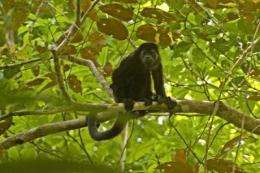Protected areas face threats in sustaining biodiversity: report

Establishing protection over a swath of land seems like a good way to conserve its species and its ecosystems. But in a new study, University of Pennsylvania biologist Daniel Janzen joins more than 200 colleagues to report that protected areas are still vulnerable to damaging encroachment, and many are suffering from biodiversity loss.
"If you put a boundary around a piece of land and install some bored park guards and that's all you do, the park will eventually die," said Janzen, DiMaura Professor of Conservation Biology in Penn's Department of Biology. "It's death from a thousand cuts."
The international team of researchers, led by William Laurance of Australia's James Cook University, conducted 262 interviews of field biologists and environmental scientists who had extensive experience working in tropical forest reserves. In all, the interviews incorporated results from 60 protected areas in 36 countries.
The researchers constructed questions to determine how the biological health of the protected areas had changed over the last two to three decades. Some queries dealt with the status of wildlife in the areas: Had large mammal or amphibian populations increased or decreased over that time period? Others asked about changes in environmental pressures: Were fires more frequent or had automobile traffic expanded?
Writing in the journal Nature, the researchers report that the protected forest areas are not serving as the "arks" that some conservationists had hoped for. Four-fifths of the areas included in the survey had experienced some declines in health. About half of the areas had suffered more serious losses to biodiversity.
Among the types of wildlife and plants most negatively affected were bats, amphibians, lizards, large-bodied mammals, stream-dwelling fish, amphibians and old-growth trees. And the researchers did not even attempt to monitor insects, fungi and other small organisms.
The scientists further observed that environmental conditions and activities occurring outside of the reserves were strong predictors of how biodiversity inside the boundaries fared. Logging, declining forest cover and increasing fires outside the protected areas tended to pull down the health of the reserves themselves. Such losses were rampant: Eight-five percent of the reserves had their surrounding forests decline in the last few decades, while only two percent had bordering forestland increase.
When Janzen and his wife and research partner, Winnie Hallwachs, became advisors for and supporters of Costa Rica's Área de Conservación Guanacaste in 1985, they worked to ensure the national park would not succumb to such threats.
Janzen said that many of the features that he and Hallwachs incorporated into the park's design are "obvious": making it socially integrated by hiring only local workers, gaining political support by winning the blessing of the Costa Rican president and incorporating habitat into the park's boundaries that will allow species to cope with climate change.
The park, which was included in the survey, is one of those protected areas holding up well on many markers of health and biodiversity — even improving on many measures since the 1980s.
"We're atypical," Janzen said. "We used to have 100 to 200 fires a year and within two to three years [of management] we were down to five to 15."
And while many protected areas have found their borders slowly chipped away by development and human encroachment, Janzen said Área de Conservación Guanacaste has "the opposite issue: the size of the original park was 10,000 hectares; right now it's 163,000 hectares, so 16 times as big as when we started."
The challenge, he said, is often acquiring the political and economic will to enact sustainable management and stave off threats from development and human activity in protected areas. And conservationists can't take a cookie-cutter approach to designing and managing protected areas, Janzen said.
"You have to fine-tune and tailor-make your park to the particular circumstances of a place: the nature of the people, the resources and the organisms."
The study authors noted that although their findings suggest that many protected areas are in trouble, their intent is not "to diminish their crucial role but to highlight growing challenges that could threaten their success."
More information: Laurance, William F., and 215 coauthors. 2012. Averting biodiversity collapse in tropical forest protected areas. Nature, DOI:10.1038/nature11318 . dx.doi.org/10.1038/nature11318
Journal information: Nature
Provided by University of Pennsylvania













